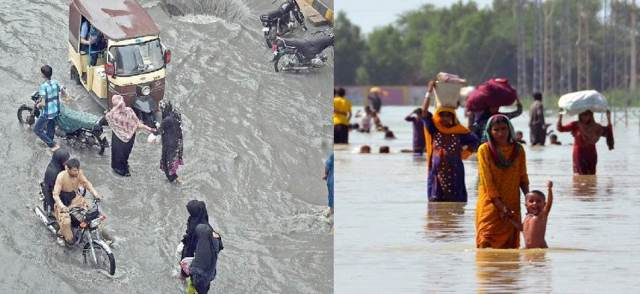Heavy Rains are expected in Sindh as well as Heavy Floods will also arrive in Sindh in Next two days
The Meteorological Department has predicted light rain again on Tuesday and Wednesday in Karachi.
According to the Meteorological
Department, light rain with thundershowers is expected in Jamshoro, Dadu,
Qamber Shahdadkot and Jacobabad today.
The Meteorological Department has
predicted that Sindh coastal belt, Badin, Thatta and Tharparkar districts may
also experience light rain and drizzle while the weather will remain normal
across the province.
Chief Meteorologist Karachi Sardar
Sarfaraz says that this rain has occurred due to the formation of turf in the
Arabian Sea.
He said that the grass in the sea will
circulate by tomorrow.
Chief Meteorologist Karachi Sardar
Sarfraz has indicated the possibility of light rain in different districts of
Sindh besides Lasbela, Hub and Khuzdar of Balochistan due to this circulation.
Heavy Floods will also Arrive in Sindh in Next two days
Already flood-prone Sindh province is
bracing for a new deluge from rivers flowing north, where the monsoon death
toll has reached 1,000.
According to the reports, the authorities have warned that the water relays will reach Sindh in the coming days, which will increase the plight of thousands of flood-affected people.
Sindh has been under heavy rains for
several weeks, which has flooded the fields across the province, but now the
streams of water coming from the mountains of the northern regions are entering
the Indus River very fast and have been continuing for a few days. .
While it looks like floods will enter the
province, the fate of millions of people in Sindh hangs on the 90-year-old dam
that diverts water from the Indus River into one of the world's largest
irrigation systems.
Sukkur Dam supervisor Aziz Soomro said
that there is a high level of flood in Sindh at the moment.
Speaking to AFP, Irshad Ali, a
42-year-old farmer near Sukkur city, lamented the damage caused to palm and
vegetable crops by the monsoon rains and said that the water reaching the river
was not feared. Is.
The Indus River is already overflowing at
many places and unless the Sukkur Dam controls the flow it will lead to
disaster.
Originally known as the Lloyd Barrage, it
was considered an engineering marvel when it was completed in 1932, capable of
releasing 1.4 million cubic meters of water per second through 19 steel gates
set between stone pillars.
"(The barrage) is 90 years old when
it had a 50-year guarantee, so we are 40 years ahead of its guaranteed
life," Water Resources Minister Khurshid Shah told to the reporters.
The bombardment diverts water into a
series of nearly 10,000 kilometers of canals that cut through the fields but
have been neglected for years, unable to handle today's record water.
Khurshid Shah said that garbage is
collected and not removed, canals have not been dug since 2010 due to lack of
equipment.
He said that the city is already four
feet below the river level.
In some areas of Sindh, only high roads
and railway tracks are dry where thousands of poor rural people have taken
shelter with their cattle.
A row of tents stretched for two
kilometers near Sukkur, where people still came in boats laden with wooden
cots, beds, utensils and food.
Labor lawyer Ahmed said that the water in
the river started rising from the previous day, which flooded all the villages
and forced us to relocate.
The dam supervisor said that each gate is
open to handle the river flow of more than 6 lakh cubic meters per second.
The floods come at a bad time for
Pakistan, when the economy is in decline and former Prime Minister Imran Khan
was ousted in April on a no-confidence motion.
River Supervisor Shahid Hussain said that
the embankment is strong, machinery is available and staff are alert.
Officials say this year's monsoon floods
have affected more than 30 million people, or one in seven Pakistanis, and
nearly a million homes have been destroyed or severely damaged, so the
government has stepped up efforts to deal with the floods. Has accelerated. A
state of emergency has been declared. .
Although the capital Islamabad and its adjacent twin Rawalpindi were spared from the ravages of floods, they too are not immune to its effects.
Tomatoes, peas, onions and other
vegetables are unavailable and prices are rising due to flooding, officials
told AFP.
Engineers were working on Sunday to
strengthen the Ali Wahan Dam, a major crossing of the Indus River in the city
that faces threats from the raging river.
He said that the good thing is the
weather, by the time the water from the northern regions reaches here, the
flood water coming from the local rains will calm down.
But if it rains again, the situation can
change rapidly.
The National Disaster Management
Authority said on Sunday that the death toll from monsoon rains has reached
1.33 and 119 people have died in the last 24 hours.
According to the statement, this year's
floods are comparable to the worst in 2010, when more than 2,000 people died
and almost a fifth of the country was submerged.
Prime Minister Shahbaz Sharif said that I
have never seen this before.
After visiting Sindh by helicopter, he
said that villages have been destroyed, thousands of houses have been
destroyed, there has been a lot of destruction.
Thousands of people were also ordered.
They avoid danger zones and stay near boiling rivers in the north, but army
helicopters and rescue teams are still safe.
Officials blame the disaster on man-made
climate change, which they say has left Pakistan with an unfairly deteriorating
climate.
Pakistan is ranked eighth in the Global
Climate Risk Index of the non-governmental organization German Watch, which is
a list of countries facing extreme weather risks due to climate change.
Corruption, poor planning Thousands of
buildings have been erected in flood affected areas based on national and local
regulations which worsen the situation.
Do you know you shouldn't shower during a thunderstorm?
During the monsoon rains, where standing
near trees, going outside and bathing in the rain are prohibited, experts have
now banned bathing during this period as well.
Yes, showering during a thunderstorm can
hurt you.
British scientists say that bathing
during stormy rains increases the risk of electric shock.
Scientist James Rawlings says that during
this time, if lightning strikes a house, it can also go through the pipes.
Although the chances are very low,
caution is necessary because electricity is loaded with negative and positive
charges, this energy must be transferred somewhere.
They say that when lightning strikes, it
takes the path of least resistance to transfer energy, meaning it chooses
conductors that can easily carry electricity from one point to another.
Meanwhile, when you take a shower, there
are two conductors around you in a pipe made of water and metal, making the
transfer of electricity easier and faster.
According to James Rawlings, electrical
discharge can travel through metal and water pipes into your shower or bathtub
and give you an electric shock.


























0 Comments
Please do not enter any spam link in the comments box